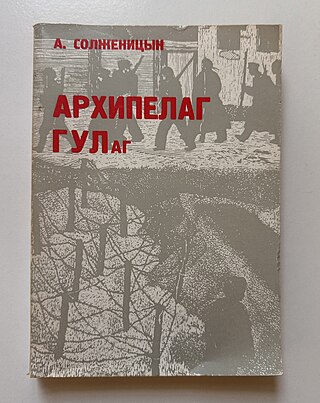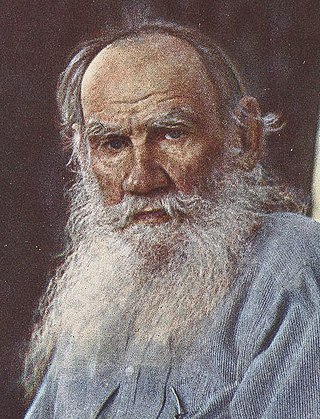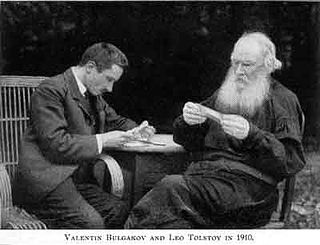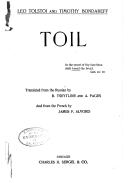Related Research Articles

Aleksandr Isayevich Solzhenitsyn was a Russian writer and prominent Soviet dissident who helped to raise global awareness of political repression in the Soviet Union, especially the Gulag prison system.

The Gulag was a system of forced labor camps in the Soviet Union. The word Gulag originally referred only to the division of the Soviet secret police that was in charge of running the forced labor camps from the 1930s to the early 1950s during Joseph Stalin's rule, but in English literature the term is popularly used for the system of forced labor throughout the Soviet era. The abbreviation GULAG (ГУЛАГ) stands for "Гла́вное Управле́ние исправи́тельно-трудовы́х ЛАГере́й", but the full official name of the agency changed several times.

The Gulag Archipelago: An Experiment in Literary Investigation is a three-volume non-fiction series written between 1958 and 1968 by Russian writer Aleksandr Solzhenitsyn, a Soviet dissident. It was first published in 1973 by the Parisian publisher YMCA-Press, and it was translated into English and French the following year. It explores a vision of life in what is often known as the Gulag, the Soviet labour camp system. Solzhenitsyn constructed his highly detailed narrative from various sources including reports, interviews, statements, diaries, legal documents, and his own experience as a Gulag prisoner.
Anarchism and violence have been linked together by events in anarchist history such as violent revolution, terrorism, assassination attempts and propaganda of the deed. Propaganda of the deed, or attentát, was espoused by leading anarchists in the late 19th century and was associated with a number of incidents of political violence. Anarchist thought, however, is quite diverse on the question of violence. Where some anarchists have opposed coercive means on the basis of coherence, others have supported acts of violent revolution as a path toward anarchy. Anarcho-pacifism is a school of thought within anarchism which rejects all violence.

The Tolstoyan movement is a social movement based on the philosophical and religious views of Russian novelist Leo Tolstoy (1828–1910). Tolstoy's views were formed by rigorous study of the ministry of Jesus, particularly the Sermon on the Mount.

An intentional community is a voluntary residential community which is designed to have a high degree of social cohesion and teamwork. The members of an intentional community typically hold a common social, political, religious, or spiritual vision, and typically share responsibilities and property. This way of life is sometimes characterized as an "alternative lifestyle". Intentional communities can be seen as social experiments or communal experiments. The multitude of intentional communities includes collective households, cohousing communities, coliving, ecovillages, monasteries, survivalist retreats, kibbutzim, Hutterites, ashrams, and housing cooperatives.

The Solovki special camp, was set up in 1923 on the Solovetsky Islands in the White Sea as a remote and inaccessible place of detention, primarily intended for socialist opponents of Soviet Russia's new Bolshevik regime.

Varlam Tikhonovich Shalamov, baptized as Varlaam, was a Russian writer, journalist, poet and Gulag survivor. He spent much of the period from 1937 to 1951 imprisoned in forced-labor camps in the Arctic region of Kolyma, due in part to his support of Leon Trotsky and praise of writer Ivan Bunin. In 1946, near death, he became a medical assistant while still a prisoner. He remained in that role for the duration of his sentence, then for another two years after being released, until 1953.

The Soviet Union introduced forced collectivization of its agricultural sector between 1928 and 1940 during the ascension of Joseph Stalin. It began during and was part of the first five-year plan. The policy aimed to integrate individual landholdings and labour into nominally collectively-controlled and openly or directly state-controlled farms: Kolkhozes and Sovkhozes accordingly. The Soviet leadership confidently expected that the replacement of individual peasant farms by collective ones would immediately increase the food supply for the urban population, the supply of raw materials for the processing industry, and agricultural exports via state-imposed quotas on individuals working on collective farms. Planners regarded collectivization as the solution to the crisis of agricultural distribution that had developed from 1927. This problem became more acute as the Soviet Union pressed ahead with its ambitious industrialization program, meaning that more food would be needed to keep up with urban demand.

Special settlements in the Soviet Union were the result of population transfers and were performed in a series of operations organized according to social class or nationality of the deported. Resettling of "enemy classes" such as prosperous peasants and entire populations by ethnicity was a method of political repression in the Soviet Union, although separate from the Gulag system of penal labor. Involuntary settlement played a role in the colonization of virgin lands of the Soviet Union. This role was specifically mentioned in the first Soviet decrees about involuntary labor camps. Compared to the Gulag labor camps, the involuntary settlements had the appearance of "normal" settlements: people lived in families, and there was slightly more freedom of movement; however, that was permitted only within a small specified area. All settlers were overseen by the NKVD; once a month a person had to register at a local law enforcement office at a selsoviet in rural areas or at a militsiya department in urban settlements. As second-class citizens, deported peoples designated as "special settlers" were prohibited from holding a variety of jobs, returning to their region of origin, attending prestigious schools, and even joining the cosmonaut program. Due to this special settlements have been called by J. Otto Pohl a type of apartheid.
Anarchism in Russia developed out of the populist and nihilist movements' dissatisfaction with the government reforms of the time.

Dekulakization was the Soviet campaign of political repressions, including arrests, deportations, or executions of millions of kulaks and their families. Redistribution of farmland started in 1917 and lasted until 1933, but was most active in the 1929–1932 period of the first five-year plan. To facilitate the expropriations of farmland, the Soviet government announced the "liquidation of the kulaks as a class" on 27 December 1929, portraying kulaks as class enemies of the Soviet Union.

Sergey Pavlovich Zalygin was a Soviet writer and environmentalist, the first non-Communist Party editor-in-chief of the monthly literary magazine Novy Mir (1986–1998).

Count Lev Nikolayevich Tolstoy, usually referred to in English as Leo Tolstoy, was a Russian writer. He is regarded as one of the greatest and most influential authors of all time. He received nominations for the Nobel Prize in Literature every year from 1902 to 1906 and for the Nobel Peace Prize in 1901, 1902, and 1909.

The Brotherhood Church is a Christian anarchist and pacifist community. An intentional community with Quaker origins has been located at Stapleton, near Pontefract, Yorkshire, since 1921.

Valentin Fyodorovich Bulgakov was the last secretary of Leo Tolstoy and his biographer. He served as the director of several literary museums and actively participated in Tolstoyan and pacifist initiatives. Endured imprisonment under the Tsarist regime and internment in a Nazi camp. For the last 20 years of his life, he assumed the role of the head at the Yasnaya Polyana museum.

Arseny Borisovich Roginsky was a Soviet dissident and Russian historian. He was one of the founders of the International Historical and Civil Rights Society Memorial, and its head since 1998.

Kulak, also kurkul or golchomag, was the term which was used to describe peasants who owned over 8 acres of land towards the end of the Russian Empire. In the early Soviet Union, particularly in Soviet Russia and Azerbaijan, kulak became a vague reference to property ownership among peasants who were considered hesitant allies of the Bolshevik Revolution. In Ukraine during 1930–1931, there also existed a term of podkulachnik ; these were considered "sub-kulaks".

A kolkhoz was a form of collective farm in the Soviet Union. Kolkhozes existed along with state farms or sovkhoz. These were the two components of the socialized farm sector that began to emerge in Soviet agriculture after the October Revolution of 1917, as an antithesis both to the feudal structure of impoverished serfdom and aristocratic landlords and to individual or family farming.

The Triumph of the Farmer or Industry and Parasitism is a treatise by Russian peasant philosopher Timofei Bondarev. The work details Bondarev's labor philosophy, in particular his idea of "bread-labor", by which every man is responsible for the physical labor required to sustain himself. The treatise captivated writer Leo Tolstoy, who began a long correspondence with Bondarev and endeavored for years to see the work published. An abbreviated version was published in 1888, and the full work was published in 1906.
References
- ↑ Josh Sanborn (March 1996). "Memoirs of Peasant Tolstoyans in Soviet Russia (book review)". H-Net Reviews.
- ↑ Karen Christensen and David Levinson (2003). Encyclopedia of Community. Sage Publications Inc. (Thousand Oaks, California). p. 713. ISBN 9780761925989.
- 1 2 Alston 2013, p. 43.
- ↑ Alston 2013, p. 41.
- ↑ Alston 2013, p. 44.
- ↑ Alston 2013, pp. 44–45.
- ↑ Alston 2013, p. 45.
- ↑ Alston 2013, pp. 45–46.
- ↑ Alston 2013, p. 46.